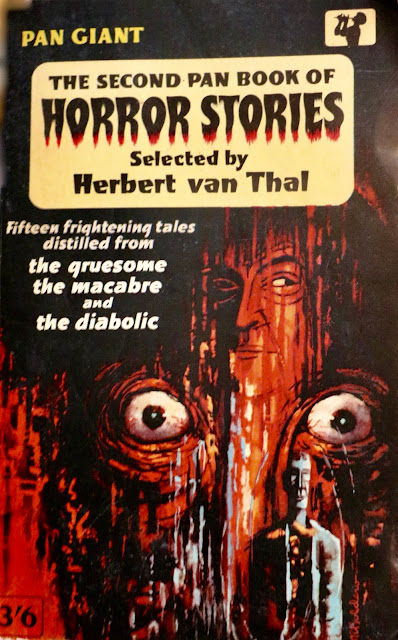I had not intended to post on works that might be seen to address aspects of the situation we currently find ourselves in with the coronavirus. But anyone who has followed my blogs would know that the process I follow when choosing works to discuss, despite my best efforts, is unpredictable. So I often find myself in unexpected territory. Like here. Last night I was reading a post on the unsubscribed blog on the Bruce Pennington covers for the work of Clark Ashton Smith.
This led me to, in a process too long to describe, to Lankhmar The Fritz Leiber Home Page.
There I found a reference to a Fritz Leiber story "Hatchery of Dreams" I recognized the story immediately upon seeing the cover of its original appearance in Fantastic Stories of the Imagination.
I still had not decided to do a post on Fritz Leiber, but while digging out my Clark Ashton Smith books (remember Alice), I found my copy of The Witchcraft Reader, which contains "The Warlock" by Fritz Leiber.
"The Warlock" begins with the confession by the narrator that he has caused his "friend" Jamie Bingham Walsh's death by forcing him off a cliff. He also makes his reasons clear right away. Jamie is a witch or warlock.
"to me a witch _ a modern witch, a real witch - is a person who is a carrier of insanity, one who infects others with this or that deadly psychosis without showing any of the symptoms himself, one who may be brilliantly sane by all psychiatric tests but who nevertheless carries in his mind-stream the germs of madness."
"By the same reasoning, Jamie Bingham Walsh should have been known as Schizo Jamie. People with whom he came in really close contact had their minds split and started to live in dream worlds."
and
" Most of us are willing to recognize the carrier of insanity when he operates at the national or international level. No one would deny that Hitler was such a carrier, spreading madness among his followers until he grew so powerful that there was no asylum strong enough to hold him." (60)
We have heard this confession, the killing of a friend for whatever reason, possession in the case of the narrator of Lovecraft's "The Thing on the Doorstep" or, in this case, the narrator holds James responsible for his sister's madness. This is a hackneyed trope across both mythos fiction and the horror tale in general. But here, Leiber provides a depth of plot and description to create a very readable psychological study. That some aspects of the story (quoted in part above) seem a bit prescient today is probably my imagination.
The second story "Hatchery of Dreams" is one I originally read years ago, in Rod Serling's Triple W: Witches, Warlocks and Werewolves. I have owned this anthology since I was a teenager. It is probably one of the of the paperbacks I have owed the longest with all the culls and moves my collection has undergone. I have no idea where it came from it was probably a gift. I suspect I will pull more stories from it to discuss in the future.
"Hatchery of Dreams" is the story of Giles Wardwell, a rather proper Bostonian who works for the CAMZ, a cold war-style organization tasked with rooting out communists. Or so, Giles thinks. The story opens when Giles wakes up and finds his much younger wife Joan missing. A note indicates she is taking a break possibly permanent from their marriage. Giles is unconvinced. First, he explores the home laboratory where Joan makes cosmetics. Here, Giles discovers a head-sized white egg that looks like it is about to hatch. Next, he visits the three young women that are Joan's bridge partners. Each is ill, the last Mary Nurse, cuddling a giant spider stuffy, tells Giles to return home for the eggs hatching if he loves his wife. "The Hatchery of Dreams" is an enjoyable story. It would probably be considered somewhat sexist today, but it is a fast paced adventure.
I would say it is not quite as interesting or well written as "The Warlock
but more fun. Leiber pulls together a lot of connections in terms of names and incidents from New England's history with witchcraft. Leiber then merges this history with McCarthyism and cold war paranoia quite effortlessly.
I would say it is not quite as interesting or well written as "The Warlock
but more fun. Leiber pulls together a lot of connections in terms of names and incidents from New England's history with witchcraft. Leiber then merges this history with McCarthyism and cold war paranoia quite effortlessly.
Witchcraft sees to be a theme that interested Leiber. We see it again in his novel Conjure Wife, and the Wikipedia article on Leiber's novel Our Lady of Darkness mentions Bruce Byfield's Witches of the Mind: A Critical Study of Fritz Leiber. This use of witches as characters and the broader references to witchcraft in the history of New England is something Leiber shares with Lovecraft. This shared interest, may in part, explain the connection between these two writers.
Covers:
The Witchcraft Reader cover by Josh Kirby
Rod Serling's Triple W: Witches, Warlocks and Werewolves This unforgivable atrocity of a cover is unattributed. I am surprised the publisher did not recall all the copies and burn them. But it was used for at least two editions, so maybe it is just me. What do you think?
Conjure Wife cover by Robert Maguire
Covers:
The Witchcraft Reader cover by Josh Kirby
Rod Serling's Triple W: Witches, Warlocks and Werewolves This unforgivable atrocity of a cover is unattributed. I am surprised the publisher did not recall all the copies and burn them. But it was used for at least two editions, so maybe it is just me. What do you think?
Conjure Wife cover by Robert Maguire















